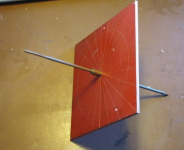Lots of folks would like to build a sundial but are intimidated by the non-linear line spacing one sees on the typical garden sundial with a triangular gnomon.
Now, if you lived at the north or south pole, making a sundial would be dead easy. Just stick a vertical stick in the ground and lay out a circle with 24 equal sectors with the pole at the center. Since the earth is revolving around the stick axis at 15 degrees per hour, the shadow of the stick will indicate the current hour on the lines of the circle.
This style of sundial is called an equatorial sundial because the plane of the 24 sector circle is parallel to the earth's equatorial plane, i.e., perpendicular to the earth's axis of rotation.
Thankfully, one doesn't have to be at the poles to build an equatorial sundial. All we need is a plate parallel to the equator with a stick/gnomon parallel to the earth's rotation axis.
The picture shows the construction. A square plate is marked with 24 equally spaced lines. In the center is a brass bushing through which the gnomon rod passes. The gnomon is slid through the bushing until, when placed on a horizontal surface as shown, the rear end of the gnomon makes an angle with the horizontal equal to the latitude of your site. This guarantees that the plate is parallel to the equatorial plane. A setscrew in the bushing holds the gnomon at this setting.
Now, we need to align the gnomon with the earth's rotation axis. You could make the gnomon point at Polaris or you could cheat like I do. Look up the time of high noon (meridian transit) at your location and, at that time, adjust the sundial until noon is indicated. Mark this position so you can return to it if the sundial is moved.
There are calculators on the internet for computing the time of meridian transit at your location. One example is...
Rise/Set/Transit Times for Major Solar System Bodies and Bright Stars
On edit...
I neglected to mention that the hour lines should be drawn on both sides of the plate. There will be occasions when the gnomon shadow is on either side. Consider what happens at the equator. The latitude is zero so the plate is vertical. During northern hemisphere summer the sun is north of the equator so the shadow falls on the north facing side of the dial. During northern hemisphere winter the situation is reversed. The sun is south of the equator and the shadow falls on the south facing side of the dial.


 LinkBack URL
LinkBack URL About LinkBacks
About LinkBacks



 Reply With Quote
Reply With Quote



Bookmarks